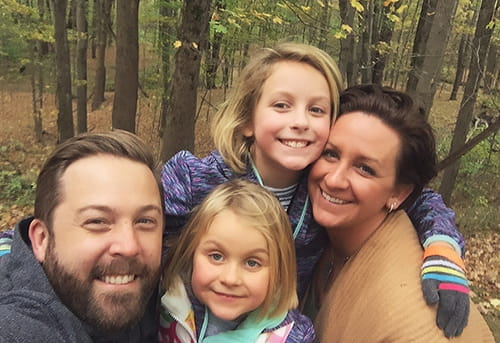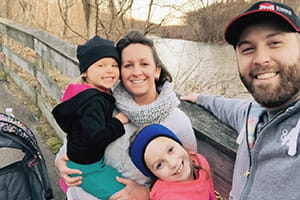Lila Manages the Many Challenges of Congenital Diaphragmatic Hernia (CDH)

Lila and her older sister Willa enjoy their first family vacation together. It took four years for the Frenches to feel comfortable enough with Lila’s medical status to be able to travel.
Doug and Ashley French woke up on a recent morning to hear their 3-year-old daughter singing a song about rainbows. Four years ago when Ashley was pregnant with Lila, they weren’t sure they would ever hear their daughter’s voice at all.
Due to a fetal condition diagnosed in utero, the Frenches were told it would be best to terminate the pregnancy. They looked for other options and found the Cincinnati Children's Fetal Care Center. The baby that Ashley was pregnant with at the time is now their spunky, singing 6 year old.
In March of 2012, Ashley went in for a routine ultrasound. She and Doug were excited to find out if their daughter Willa, then 4, would be welcoming a little brother or sister to the family. They learned the baby was a girl, but the ultrasound showed her heart was pushed under her left armpit, which caused some alarm. The Frenches soon discovered that their baby’s heart was in the wrong place due to a condition called congenital diaphragmatic hernia, or CDH.
What is CDH?
CDH occurs when the diaphragm—the layer of muscle between the abdominal cavity and chest cavity—does not close the right way during the baby’s development. The abdominal organs push (or “herniate”) through the opening into the chest cavity, pressing on the lungs and preventing them from developing normally.
That was the case with Ashley and Doug’s baby, Lila. The entire right side of Lila’s diaphragm was missing, and her liver, stomach, and intestines had pushed their way up to crowd the heart and lungs. Typically the liver sits just above the stomach. Lila’s liver was touching her collarbone. Doctors called it a severe case of CDH.
“We heard those three letters and it turned our world upside down,” Ashley said. “We didn’t know what we were in for.”
But they did know they wanted to give their baby girl every chance at survival that they possibly could. So they traveled four hours from their home in northern Ohio to the Fetal Care Center for an evaluation.
‘We knew we were in the right place’
The day-long consultation provided them with in-depth information about CDH, as well as what to expect throughout the pregnancy, after delivery, and beyond. “We found out more details about the condition and how severe it really was,” Ashley recalled. Lila’s condition was serious, but there was a chance she could survive it. “It was scary but we got hope. The doctors gave us the option to go the distance. That’s when we knew we were in the right place.”
The Frenches learned that Ashley’s care team at the Fetal Care Center could work closely with her maternal-fetal medicine specialist (MFM) in Akron. That meant they could go back home for the rest of the pregnancy and Ashley could be monitored from afar. Ashley returned to Cincinnati twice for fetal imagings so the doctors could get a close look at Lila’s organs.
The MRI at 33 weeks showed that Lila’s condition was worsening. Her lungs were still small and underdeveloped. Ashley and Doug were told that Lila’s chance at survival was just 20 percent.
“We still wanted to continue with our plan at that point. We wanted no regrets,” Ashley said. In case of the need for an emergency delivery, Ashley’s care team, led by Foong-Yen Lim, MD, advised her to return to Cincinnati at 36 weeks. “So we packed up over the 4th of July and moved to Cincinnati,” Ashley said. They rented an apartment near the hospital and brought the whole family—Doug, Ashley, Willa and their two dogs. If Lila’s lungs were strong enough to keep her alive, the Frenches were prepared for a long stay in the neonatal intensive care unit (NICU).
“I feel extremely grateful for how prepared we were. My care team laid everything out for us when our plan was put in place. It was done extremely well and was very well thought-out,” Ashley said.
Straight to the NICU
Ashley and Doug welcomed Lila into the world on July 19, 2012, with a scheduled C-section at the Fetal Care Center. Lila was immediately prepped to be put on ECMO (extracorporeal membrane oxygenation), a type of heart-lung bypass machine. ECMO bypasses the narrow blood vessels in a baby’s lungs, giving the lungs and blood vessels the chance to rest and develop. That began Lila’s lengthy stay in the NICU.
When she was just 2 days old, she underwent surgery to move her organs back into their proper place and repair her diaphragm. After that, Lila continued her intensive care to get her lungs to develop well enough so she could breathe on her own, allow time for the surgical repair to heal, and to become successful at feeding.
With the odds stacked against her, Lila prevailed. After 119 days in the NICU and countless ups and downs, Lila was at last able to go home with her family.
Thriving amidst struggles

As with many babies who have CDH, other health issues continue long after the NICU stay is over. For Lila, this has meant feeding challenges (she is g-tube dependent), pulmonary hypertension (a disease of the blood vessels in the lungs), and some developmental delays including a speech delay.
Her team of cardiologists, surgeons, and other experts have been with Lila for seven years now, continuing to see her for regular checkups. “We don't know what we would do without them,” Ashley says. “They are the crème de la crème!”
And Lila is thriving in many ways. She is a bubbly, bright kindergartner who is determined to live and to live happily. Her comical personality brings sunshine to her family and to everyone she meets.
That makes it all worthwhile for Ashley and Doug. They’re confident the expertise of the Fetal Care Center is why Lila is alive today. “If we wouldn’t have gone to Cincinnati, I know she wouldn’t have made it,” Ashley says. “To want a family of four and to have that possibly taken away is heartbreaking. And then to go somewhere and be offered hope—it’s a gift.”
“We don't know why paths weave and turn like they do,” she explains, “but we take on whatever challenge is laid before us together as a family, and we do that with Cincinnati Children's in front of us to help us make the best possible choice and give our girls the best chance and quality of life.”
Updated: May 2019





